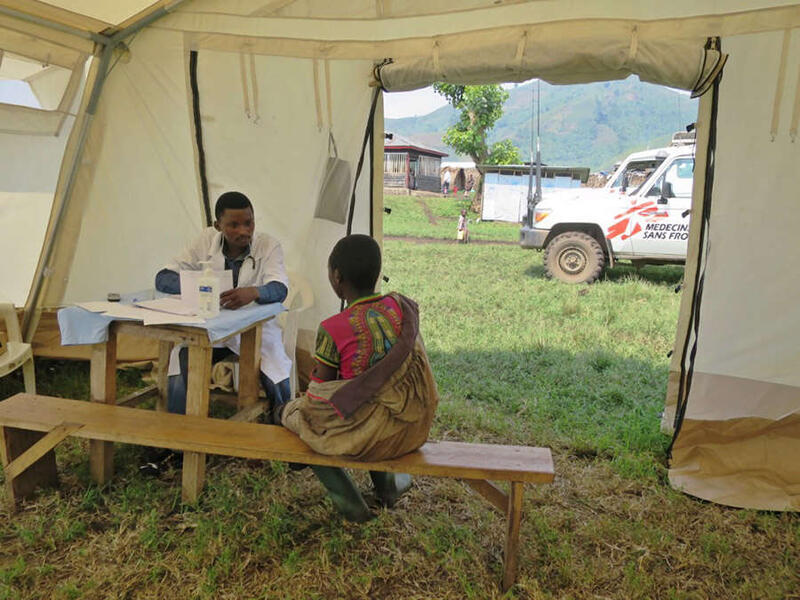Malaria kills around 660,000 people a year, world-wide. When the number of cases in North Kivu reached emergency levels, Emily and the rest of the team had to work fast to set up mobile malaria clinics at different sites across the region. In her last photo blog, Emily showed how the team worked quickly to get the clinics set up. In this post, she blogs about what happens when patients start to arrive...

At first, not everyone was aware that our clinics were there and that testing and treatment was free. Timid at first, we received just a few patients on the first two days, but after cured patients started going back into the community and spreading the word, people were arriving on mass!

Some were very keen!

The first thing we do in the clinics is register the patients and triage based on their symptoms. Patient names and ages are taken, as well as a few more personal details, plus their temperature. Those with high temperatures are triaged as a priority for testing, as high fever is one of the primary symptoms of malaria.

At the same time as registering the patient, we take the MUAC (Mid-Upper Arm Circumference). This is a good and fast indicator of whether or not a child is suffering from malnutrition.
In this project we need to get an idea of the nutritional status of the population and therefore we take MUAC data for every child between 24 and 59 months who enters our clinic, whether they are a patient or not!
We know there are food shortages here and the more displaced people that arrive, the less food there is to go around, so the data will help us understand the extent of the medical needs associated with this.

The MUAC is measured with a simple band showing three colours: green means the child is well nourished and does not need treatment; yellow indicates a risk of acute malnutrition and the need for follow up, orange shows moderate acute malnutrition (MAM) and red indicates severe acute malnutrition (SAM).
We refer children on the orange and red scale to the Kashuga Health Centre. Kashuga has a permanent health centre where children can be assessed for whether they need to be entered into the malnutrition programme that MSF supports there.

The patient is then weighed and the details added to their registration card. Some fit better than others on the scale!

For tiny babies who are not yet able to stand, we use a sling hanging from a different set of scales.

This little one was just a few weeks old. She had a very high fever and was not very impressed by the weighing process.

After the registration it’s the malaria test. This is a quick-diagnosis blood test that is very simple to train people to do – even I can do it!
The test involves pricking the finger with a needle, taking a tiny blood spot and putting it onto the test strip. We then add solution that reacts with the blood if the patient has malaria. You have to wait 15 minutes for the result. A single red line means negative and a double red line means positive – as you can see from the picture above, the majority of tests we did were positive.

Next up it’s consultation. Every patient we receive who tests positive for malaria is consulted. They are asked details about their symptoms, malaria net usage, as well as where they are from.
Knowing where patients have arrived from helps us identify if there is an area from which a lot of cases are originating, as it could indicate a need for an MSF intervention there too – many people walk for hours or sometimes even days to reach our clinics as they are the only free health care for miles around.
People who are unwell but who test negative for malaria we refer to the Kashuga Health Centre, which is able to treat a wider range of illnesses than the simple malaria our emergency team is here to deal with.

Once consulted and prescribed medication, the patient continues to the pharmacy. Children are given their first dose in the clinic to make sure they are able to take it. If they are too sick to keep the medication down orally then we may have to give the child the medication by injection or suppository.
The medication is crushed into water and given onto a spoon to the child. It tastes gross!
With experience, the pharmacists have found that covering the child’s eyes during this process has a much higher success rate than if they see what’s on the spoon!
Once the child has taken the medication and has waited 15 minutes without it coming back up again, they are free to go. Their parents or brothers and sisters are given instructions for when and how to give the remaining doses.

Wherever there is a chance, team members and health educators use their time to spread messages about malaria, prevention, treatment and the clinic operating hours. These are adjusted to the needs that rise throughout the intervention.
For example, a few days into the clinics we were receiving a large number of child patients being accompanied by other young children. This was a problem as we cannot give medication and administration instructions to a child to follow in case they misunderstand and get it wrong, which could make the patient even sicker.
When this happened, we asked the health educators to walk around the camps and town with megaphones, passing the message that all child patients must be accompanied by an adult in order to receive treatment.
Whilst the team is working hard to diagnose and treat people with malaria, they also know that prevention is better than cure. Read Emily's next instalment here, and find out how the team is working to reduce the number of people getting infected.





